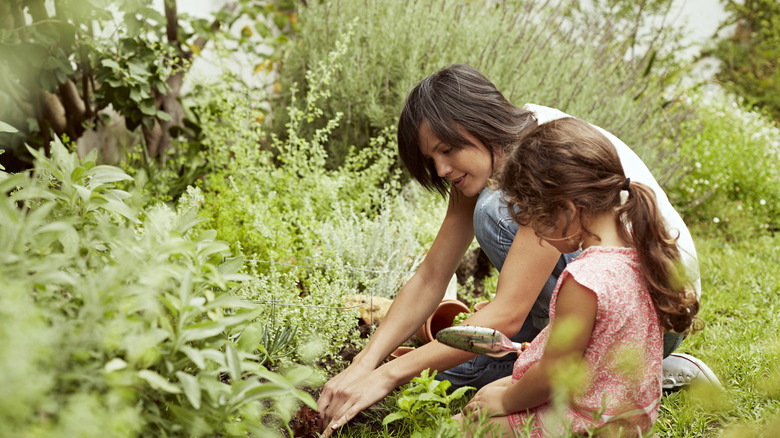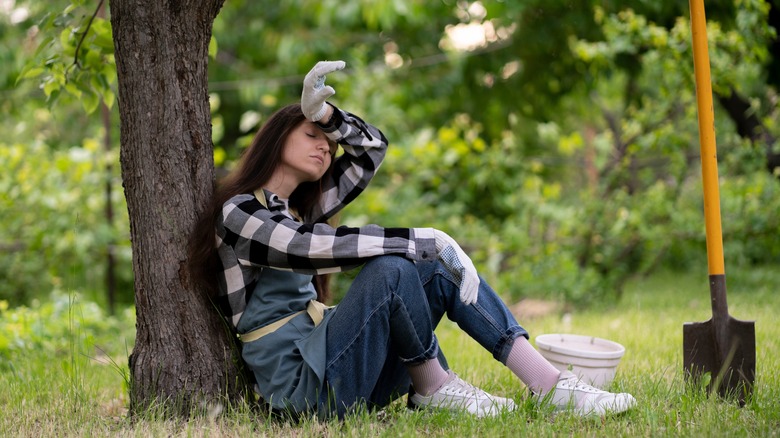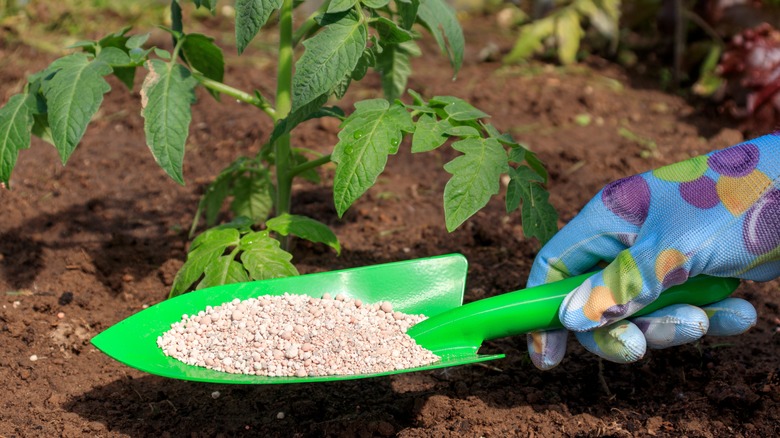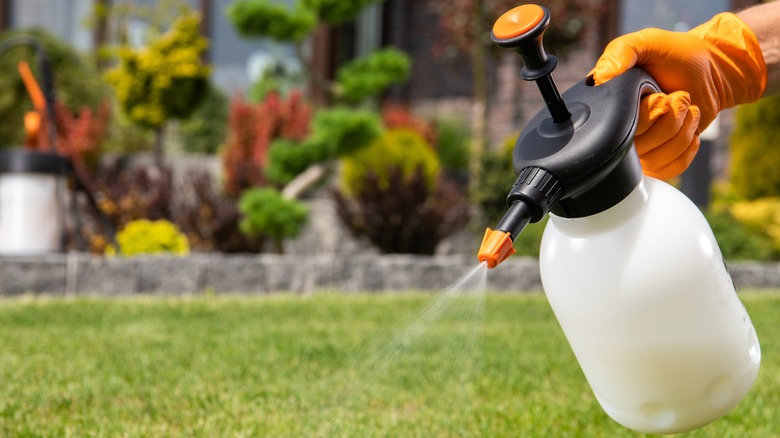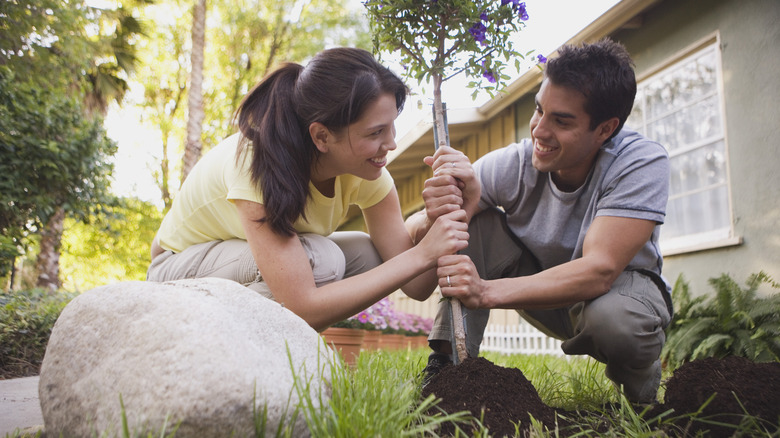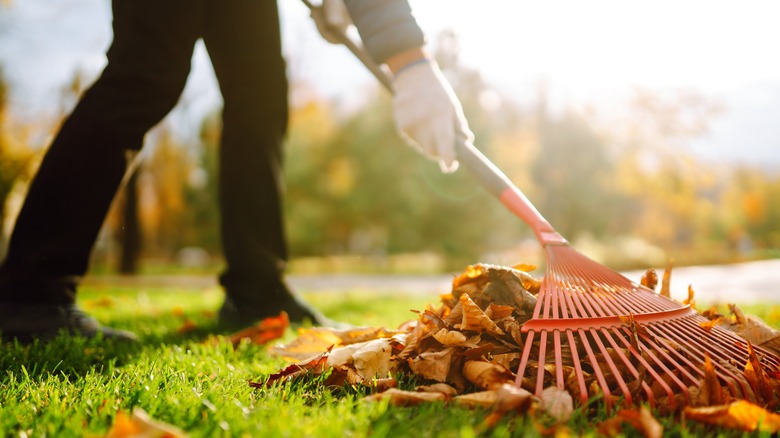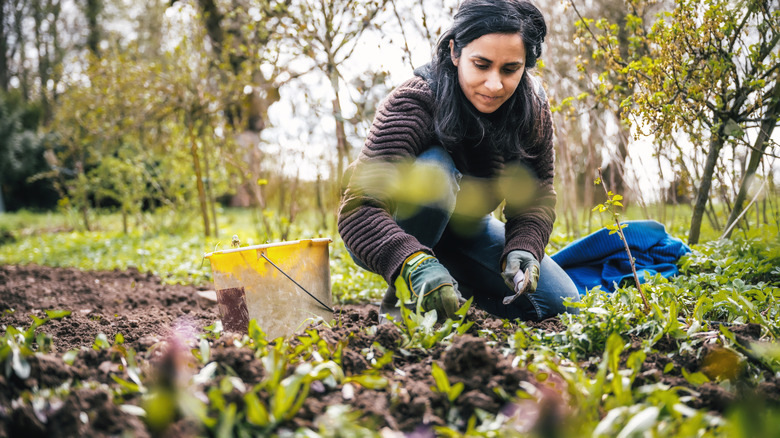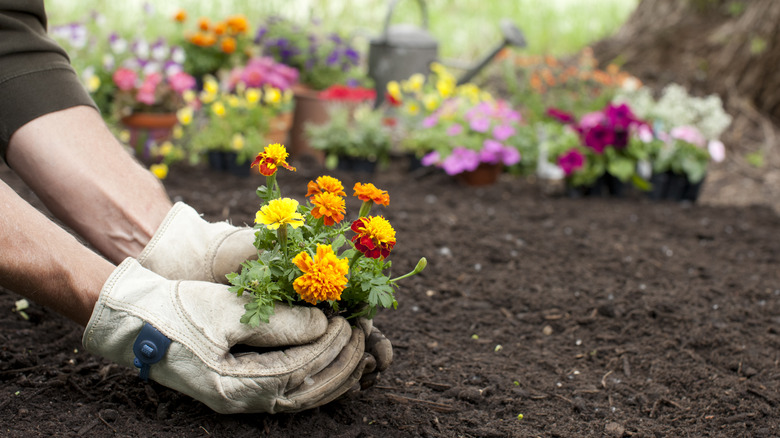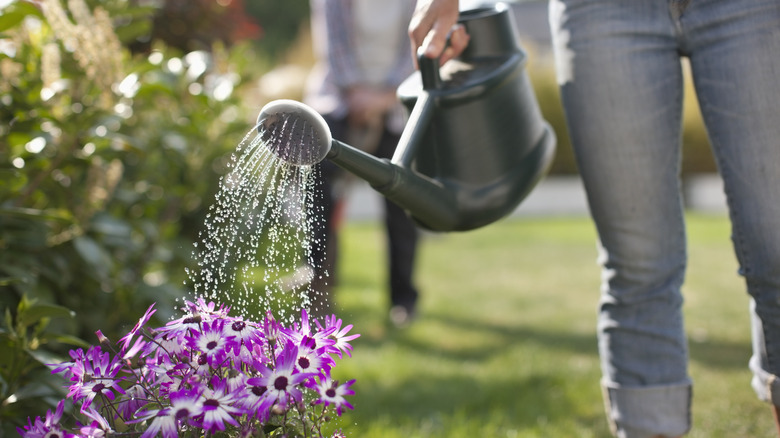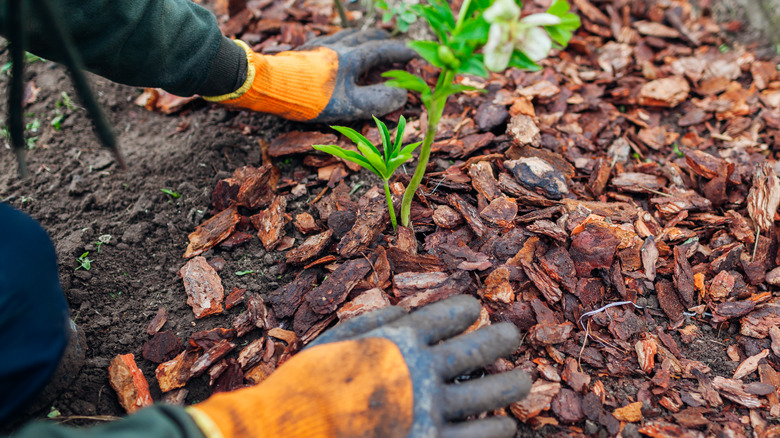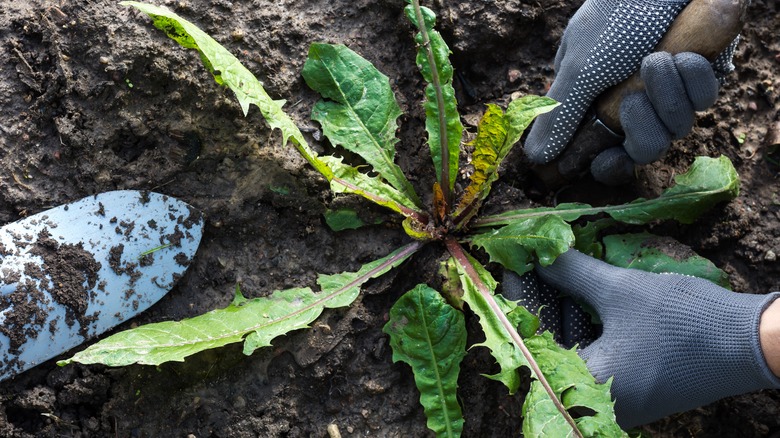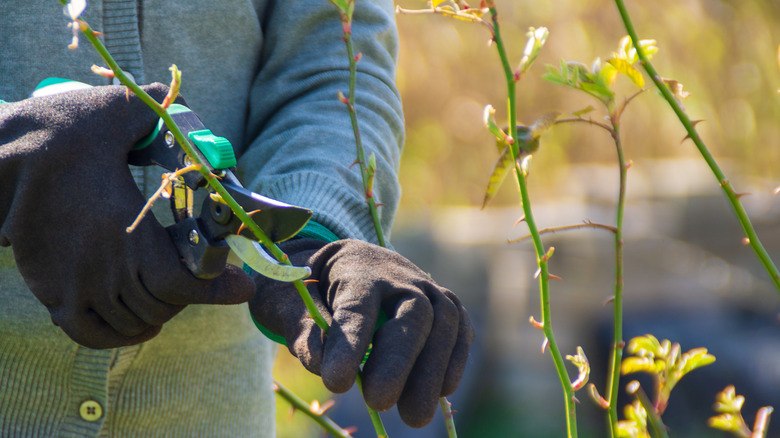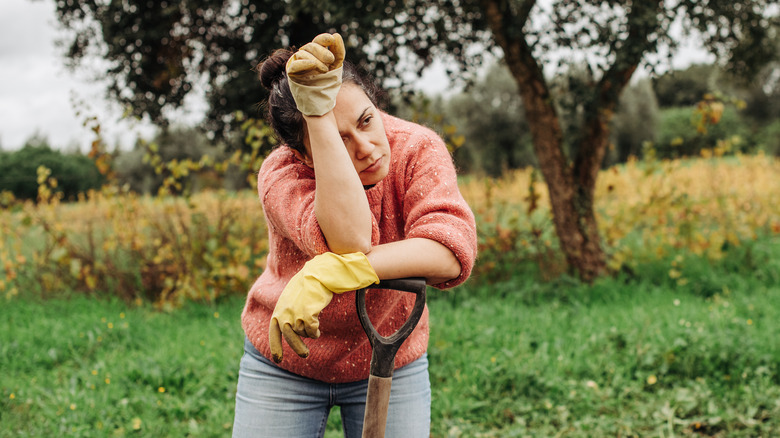12 Mistakes You Want To Avoid As A Beginner Gardener
Getting your hands dirty, your fingers green, and immersing yourself in the fundamentals of sowing, growing, and pruning is good for the soul. However, if you're new to the gardening game, it's easy to fall into rookie mistakes that newcomers the world over have been making since day one. Whether that's biting off more than you can chew, not paying attention to the soil, or planting flowers during the wrong times of the year, there are some key missteps to look out for.
But before you get too disheartened, always remember that every gardener, no matter how accomplished, only got to where they are now through a series of trials and errors. Beginners in any discipline have a habit of falling flat on their faces before becoming true masters of the universe. Gardening takes time to get right, but the journey is a rewarding one. Here are a few pitfalls you need to avoid as you work your way up the ranks to the elevated status of a master gardener.
Setting your sights too high
One of the most common mistakes newcomers to the shovel, rake, and trowel make is thinking they can run before they can walk. There's nothing wrong with dreaming big, but when you're writing checks your skillset cannot cash, the garden can soon become a hostile and unforgiving environment. Horticulturist and master gardener Barbara Murphy told AP News, "Starting too large is the most common mistake made by first-time gardeners. Limit yourself to 10 feet by 10 feet. If you grow frustrated because of too many things happening the first year, there's a good chance you won't feel like gardening for a second. You can always expand as your skills develop."
Planting more than you can grow is like biting off more than you chew — a recipe for disaster! Start by earmarking a small area that is bathed in direct sunlight for at least six hours a day. The site should have adequate drainage to withstand heavy rain. Your garden needs sun, water, and nutrients to flourish, so don't locate it near trees and shrubs that could easily steal all three. Once you've picked the location, plan its shape and visualize what crops will go where. Gardening can be physically taxing, so remember to factor in how much work your little patch of creation will require. Grab the hoe, rake, and spade, and get busy.
Using too much synthetic fertilizers
Before you begin creating the garden of your dreams, you should test the soil to see what and how much fertilizer you'll need to apply. When each crop is harvested, it carries some vital nutrients from the ground with it. Over time the soil will need to be replenished with further nutrients in the form of fertilizers. Nitrogen, phosphorus, and potassium are the most common fertilizers, and many beginner gardeners often fall into the trap of being careless with them. Veteran gardener Jeff Lowenfels told The Washington Post, "The one thing we do in gardening, we fertilize mindlessly without really knowing what we are doing. We know very little about how plants use nutrients, and we should know a lot more about our favorite objects."
Many beginner gardeners think more is better when it comes to fertilizer. However, too much can damage your plants. In order to keep from overfertilizing, many experienced gardeners choose only to use natural alternatives, such as rotted compost, leaf mold, or a supplemental mix of alfalfa meal, bonemeal, greensand, and kelp. You can spot an overfertilized garden by a layer of white crust that will appear on the soil's surface. If this happens, you'll need to water the area extensively.
Using synthetic pesticides
So you've sown the seeds, planted the plants, and everything is growing nicely. And then along comes not so much a spider, but a gluttonous slug or snail that lays waste to your prize tomatoes. It's a common predicament many gardeners face, and the temptation to reach for a handy spray bottle of synthetic pesticide can be overwhelming. But ask yourself, do you really want to be that person? Synthetic pesticides have a depressingly wide kill range. When you use them in your garden, they destroy beneficial bugs such as bees, which pollinate, and spiders and ladybugs, which help keep pesky bugs in check.
Beginner gardeners need to know the difference between destructive insects and those beneficial to their garden's ecosystem. To keep your garden as natural as possible while also deterring harmful insects, purchase disease- and pest-resistant seeds. Additionally, keep on top of your weeding regimen, because insects and parasites love to set up shop in them. Be vigilant about removing decaying plant matter that might be attractive to insects. Diatomaceous earth and lemon balm are great at keeping bad bugs away, as are birds. Attract them to your yard with some houses and feeders.
Getting the planting location wrong
It's common for beginner gardeners to want to plant as many things as quickly as possible and wait for nature's magic alchemy to do her thing. Yet before you get digging, take a step back, draw a deep breath, and think long and hard about what should go where for the best results. Getting the planting location wrong can make the difference between a flourishing and a failing garden. Experienced gardeners swear by the golden rule of the '"right plant, right place." Some plants thrive in direct sunlight, while others have no problem growing big and healthy in the shade. For example, tomatoes, sweetcorn, potted chilies, and herbs such as oregano, basil, and thyme are proper little sunseekers. Whereas broad beans, spring cabbages, and harvest spinach are suckers for the shade.
Most purchased plants come with care instructions, but you can also look up what conditions they require on the internet. Growing a plant in its preferred environment, whether that be damp or parched soil, shady or sunny conditions, is essential for its happiness and that of your garden.
Not paying attention to the seasons
Doing the right thing in your garden at the right time of year is the key to success. Spring heralds the dawn of new life and is the time for sowing seeds, planting shrubs, composting mulch, and making inroads into the weeding and mowing. Summer is when everything comes to fruition and a time for you to reap what you have sown. Nevertheless, there is still plenty of feeding, pruning, and mowing to take care of.
The cardinal error is to believe everything grinds to a halt in autumn. Wrong! Autumn is the time to plant spring bulbs and hedge plants, bare-root shrubs, and roses. It's a great idea to plant some late-flowering plants in autumn to give your garden some color as it heads into the barren winter months. Plants such as Japanese anemones and rudbeckias will flower until the frosts come calling, and they'll also provide a last nip of pollen for the bees. When the cold jaws of winter bite, the garden may seem like a wasteland, but keep it primed and ready for when the cycle of life begins anew.
Ruining the soil
Although many beginner gardeners aren't afraid to get their hands dirty, they fail to appreciate the importance of dirt. Your soil is where your plants turn for the water and nutrients they need to thrive. Because of that, there are some things you need to avoid when it comes to dirt. Walking on the soil after heavy rainfall is a big no, no. Although admiring the beauty of your garden after a summer soaking may be tempting, your footsteps can compact the soil and make the life of your plant's roots that much harder. Always wait for the soil to dry before you walk about.
Adding sand is a trick many gardeners use to break their soil particles up, but be warned; it can also damage your soil and turn it into something resembling cement. Try using shredded leaves or grass cuttings to loosen your dirt instead. Although tilling may be required when the ground becomes extremely compacted, it's always best to avoid disturbing the earth if you can. You're at risk of bringing weeds to the surface and threatening the soil's structure. Digging is often unavoidable, but try to minimize it to six inches. Adding nutrient-rich compost to it is always better than over-digging. After all, topsoil is your friend! Always lay two or three inches of this dark and rich wonder stuff over any existing soil before beginning a new garden.
Not giving plants enough space to grow
Plants are like people. We need plenty of space and opportunity to reach our full potential. Just like a cramped environment will stunt a person's growth, the same rules apply to plants. All plants need sufficient light, water, nutrients, and space to survive and thrive. Although it's nice to have abundant variety in your garden, when plants are packed together too densely, they will not grow, develop, or flower properly and are at risk of developing diseases. When plants haven't enough space, their roots cannot properly establish themselves, nor can they absorb the necessary nutrients from the soil.
Overcrowding can also cause your taller plants to gobble up all the sunlight and leave your small plants to wither because photosynthesis cannot take place. Plants that don't have enough space to grow will often release compounds called allelochemicals that act as a natural herbicide to other nearby plant species. Allelochemicals can inhibit the growth of a root, disrupt protein synthesis, and prevent photosynthesis. To nip this sort of chaos in the bud, do yourself a favor and ensure all your plants are given the space they need. A new garden may look sparse for a period, but you should always have plenty of healthy gaps.
Getting the watering regimen wrong
Probably the most common mistake beginner gardeners make is not getting the watering regimen right. Plants need water, but too much can drown them. On the other hand, if you err on the side of caution, you risk causing them to dehydrate and die. Keeping the soil moist is integral to success, but don't be afraid to let it dry out a little before watering. This is beneficial for the roots. However, it all depends on the type of plant you have. Look up care instructions to see how often they need to be saturated.
For general watering instructions, early morning or late afternoon are the best times because less water evaporates, and the plants can replenish themselves before or after another day of sun. Be careful not to soak the leaves because they can burn during the day or be infected with mold-based diseases at night.
When watering, ensure an adequate supply penetrates the topsoil and sinks to the roots. You need to begin gradually to ensure there's no run-off, and it's wise to lightly dampen one area before moving on to the next, then return to give it a fuller soaking. Always water in a circular motion around the plant to ensure even distribution and prevent one-sided root growth. Waterlogging must be avoided at all costs because it can damage oxygen supplies and drown the plant's roots. It's also advisable to use clay-rich soil as it has better water retention. When it comes to measuring your water regimen appropriately, always let the soil be your guide.
Not using mulch
As a word, mulch has a strange, almost unsavory ring to it. Yet it is an essential part of any serious gardener's toolkit. Mulch comes in all shapes and sizes, but in essence, it is simply a covering that helps soil retain moisture, improve its quality, suppress weeds, protect it from extreme temperatures, provide nutrients, encourage beneficial organisms, and simply enhance your garden's aesthetic. Mulch comes in biodegradable and non-biodegradable varieties. Wood chippings, leaf mold, compost, and seaweed are all biodegradable mulches that slowly improve the soil by breaking down and adding nutrients. They will need to be topped off as the dirt gradually absorbs them over time.
Non-biodegradable mulches such as stone chippings, slate, and gravel are usually used to keep weeds at bay and help lock the moisture in. They do not nourish the soil in the same way as bio-degradable mulch does. However, they can be more convenient since they don't need to be reapplied.
Mulch is usually applied from the middle to the end of spring and autumn. However, it can be used any time of the year to establish a new plant and retain moisture in the soil. Biodegradable mulch should be between two and three inches thick and be applied to moist soil. You don't want to pack it directly next to the stems and trunks of plants and trees, but keep mulch 1 to 6 inches away from them, depending on their size. Not doing so can suffocate the plant, opening it up to disease and root death.
Not removing weeds
Make no mistake about it! Since the first seed was sown, weeds have been the common enemy of gardeners everywhere. Weeds are rangy and unattractive and can quickly take over a garden at the expense of prettier and more pleasing plants. Yet many beginner gardeners don't make it a priority to remove them.
Because they know how to feed and feed well, weeds have a habit of stealing nutrients, growing tall, and blocking out the sunlight. This is bad news for your more modest and retiring plants. Weeds will obscure everything great about your garden from view, and all sorts of pests love them because they present the perfect camouflage. They can also carry diseases that insects will pick up and pass on to other plants. Weeds such as pigweed, thistle, and lamb's quarter can also contain allelopathic compounds that can create infertile patches in your yard. Plus, if there's one thing weeds do well, it's reproduce. Fail to tackle the situation, and it'll only get worse. As a plus, pulling weeds is very therapeutic and one of the joys of being a gardener.
Being afraid to prune
Although trimming a rose bush can at times feel like a crime against nature, it's essential to prevent disease, encourage flowering, and keep it healthy. A rose bush that isn't pruned will quickly lose its shape and weaken. What applies to roses, applies to all plants, and beginner gardeners should never be afraid to prune! As plants grow, they need to distribute water and nutrients. As a result, some parts of a plant will become less productive over time. Its blooms will not blossom as well, and its fruits will not grow, giving the plant a faded look. Pruning can help tackle this by removing the parts of the plant that are no longer fit for purpose and help rejuvenate those that are.
Formative pruning usually applies to trees, shrubs, and rose bushes. It works by removing areas of the plant and directing energy to other parts until it takes on a particular shape. A classic example is when you encourage growth by cutting a stem to promote the area below to fan out. Maintenance or "light touch" pruning is usually carried out annually, and it aims to keep the plant healthy and promote fruit and flower growth. It's maintenance pruning that beginner gardeners should familiarize themselves with. Wait for their leaves to drop and the arrival of winter before pruning woody shrubs or herbaceous perennials, and evergreens should be pruned in spring. Always cut above the bud and at a 45-degree angle.
Giving up when things get difficult
The longest journey begins with the smallest step, and it takes time to build the garden of your dreams. It's easy to get frustrated at the many pitfalls and hiccups along the way, such as weeds that have a life of their own, an evergrowing army of pests undoing all your hard work, or the terrible threat of blight. However, what doesn't kill your garden will make it stronger, and perseverance has its own reward. When you feel like quitting, don't! Treat every setback as a learning curve and an opportunity to grow.
It's a common mistake for beginner gardeners to be too harsh on themselves. If sections of your garden are overgrown and every weed isn't pulled, don't beat yourself up about it. We lead busy lives, and there are only so many hours in the day. The most important thing is to enjoy your garden and accept no one gets everything right the first time around. So stay positive, don't quit, and your garden will reward you with the fruits of your labor.
